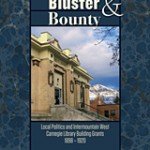Title: Books, Bluster, and Bounty: Local Politics and the Intermountain West Carnegie Library Building Grants, 1898-1920
Author: Susan H. Swetnam
Publisher: Utah State University Press
Genre: History
Year: 2012
Pages: 251
Binding: Hardcover
ISBN: 978-0-87421-842-8
Price: $32.95
Reviewed by Ivan Wolfe for the Association for Mormon Letters
The subtitle of this study states exactly what this book covers. Susan Swetnam has done serious and solid research that looks at the history of the Intermountain West (here defined fairly broadly) through the eyes of communities aiming for grants from Andrew Carnegie (retired and living the life of a philanthropist) to build public libraries. Using letters sent to and from Carnegie and his assistants (particularly James Bertram) regarding the libraries, various local newspaper accounts, and myriad other sources, Swetnam recreates the debates in various communities – debates that (as she acknowledges but never really develops in detail) reflect many contemporary debates about the proper use of public funds (this was important because a Carnegie library meant a community had to pledge a certain amount of monetary support and extra taxes to maintain it after it was built).
Based on her findings, she groups various communities into thematic chapters.
After some necessary background information for her study and the historical era in the Introduction and Chapters 1 & 2, each chapter focuses on communities that shared some features in common in how they attempted to gain support for a Carnegie library.
Chapter 3 deals with how “boom towns” dealt with exploding populations and a rigorous application process that often forced them to apply for libraries inadequate for their surging population.
Chapter 4 deals with small Mormon communities in Utah and how they justified libraries as ways to keep the youth out of trouble.
Chapter 5 shows that “religiously diverse” Utah communities sometimes came together despite their differences and were models of interfaith cooperation – and sometimes the non-Mormon element hoped the libraries would help educate Mormons to leave their faith.
Chapter 6 focuses on communities where women had very prominent parts in brining the libraries to town.
Chapter 7 deals with places that felt a library would help reinvent the community.
Chapter 8 deals with libraries that were attempts at increasing a prominent person’s personal power.
Chapter 9 deals with libraries that were often hotly contested (Provo, Utah features in this chapter as the debate there was not religious in nature but focused on east Provo vs. west Provo politics).
Chapter 10 is an able conclusion to the whole work.
Overall, this book functions as an interesting academic study that focuses on an often overlooked part of American history. Anyone interested in how communities, especially in frontier areas, defined themselves should be interested in this work. The only real complaint I might have is that each chapter could likely be made into a book itself. Often there were personalities and conflicts that sounded immensely interesting but received only scant detail, though given the nature of the study, that likely couldn’t be avoided. Perhaps this book will inspire someone else to write a more detailed study on some of these fascinating areas of history.

